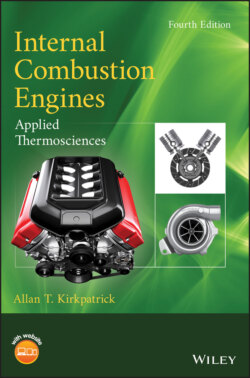Читать книгу Internal Combustion Engines - Allan T. Kirkpatrick - Страница 50
2.4 Constant Pressure Energy Addition
ОглавлениеThis cycle is often referred to as the Diesel cycle and models a gas engine cycle in which energy is added at a constant pressure. The Diesel cycle is named after Rudolph Diesel (1858–1913), who in 1897 developed an engine designed for the direct injection, mixing, and autoignition of liquid fuel into the combustion chamber. The Diesel cycle engine is also called a compression ignition engine. As we will see, actual diesel engines do not have a constant pressure combustion process.
The cycle for analysis is shown in Figure 2.3. The four basic processes are:
| 1 to 2 | isentropic compression |
| 2 to 3 | constant pressure energy addition |
| 3 to 4 | isentropic expansion |
| 4 to 1 | constant volume energy rejection |
Figure 2.3 The Diesel cycle (, ).
Again assuming constant specific heats, the student should recognize the following equations:
Compression stroke
(2.21)
Energy addition
(2.22)
Expansion stroke
(2.23)
where we have defined the parameter , a measure of the combustion duration, as
(2.24)
In this case, the indicated efficiency is
(2.25)
The term in brackets in Equation (2.25) is greater than one, so that for the same compression ratio, , the efficiency of the Diesel cycle is less than that of the Otto cycle. However, since Diesel cycle engines are not knock limited, they operate at about twice (20:1) the compression ratio of Otto cycle engines. For the same maximum pressure, the efficiency of the Diesel cycle is greater than that of the Otto cycle.
Diesel cycle efficiencies are shown in Figure 2.4 for a specific heat ratio of 1.30. They illustrate that high compression ratios are desirable and that the efficiency decreases as the energy input increases. As approaches one, the Diesel cycle efficiency approaches the Otto cycle efficiency.
Figure 2.4 Diesel cycle characteristics as a function of compression ratio and energy addition ().
Although Equation (2.25) is correct, its utility suffers somewhat in that is not a natural choice of independent variable. Rather, in engine operation, we think more in terms of the energy transferred in. The two are related according to Equation (2.26).
(2.26)
The indicated mean effective pressure (imep) is represented by the same equation, Equation (2.20), as the Otto cycle:
(2.27)
Maximizing the mean effective pressure is important in engine design so that one can build a smaller, lighter engine to produce a given amount of work. As shown in Equation (2.20), there are evidently two ways to do this: (1) increase the compression ratio , and (2) increase the energy input . However, there are practical limitations to these approaches. For spark‐ignition engines of conventional design, the compression ratio must be low enough to avoid engine knock; whereas for diesel engines, increasing compression ratio increases engine friction. Other more complicated factors influence the selection of compression ratio, especially constraints imposed by emission standards and, for some diesel engines, problems of startability.
One might expect that we can increase by increasing the fuel flowrate delivered to an engine. As we shall see in our studies of fuel–air cycles in Chapter 4, this is not always correct. With fuel‐rich mixtures not all of the fuel energy is used, since there is not enough oxygen to burn the carbon monoxide to carbon dioxide nor the hydrogen to water. The fuel–air cycle predicts that the efficiency decreases as the mixture is made richer beyond stoichiometric.
According to the gas cycles, and to the fuel–air cycles to be discussed later, the efficiency is greatest if energy can be added at constant volume:
(2.28)
Why then do we build engines that resemble constant pressure energy addition when we recognize that constant volume energy addition would be better? To illustrate how difficult that question is let us ask the following: Suppose that the maximum pressure in the cycle must be less than some value . How should the energy be added to produce the required work? The answer is now
(2.29)
This can be demonstrated with the aid of a temperature‐entropy diagram. If the Otto cycle and the Diesel cycle are drawn on such a diagram so that the work done in each cycle is the same, it can then be shown that the Diesel cycle is rejecting less energy and must therefore be the most efficient.
